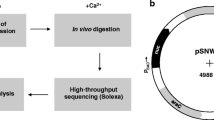Abstract
In order to study DNA replication control elements in cyanobacteria we cloned and sequenced the dnaA gene from the marine cyanobacterium Prochlorococcus marinus. The dnaA gene is ubiquitous among bacteria and encodes the DNA replication initiation factor DnaA. The deduced amino acid sequence of the P. marinus DnaA protein shows highest similarity to the DnaA protein from the freshwater cyanobacterium Synechocystis sp. PCC6803. Using a solid-phase DNA binding assay we demonstrated that both cyanobacterial DnaA proteins specifically recognize chromosomal origins, oriC, of Escherichia coli and Bacillus subtilis in vitro. The genetic environment of dnaA is not conserved between the two cyanobacteria. Upstream of the P. marinusdnaA gene we identified a gene encoding a putative ATP-binding cassette (ABC) transport protein. The gor gene encoding glutathione reductase lies downstream of dnaA. Comparison of the genetic structure of dnaA regions from 15 representative bacteria shows that the pattern of genes flanking dnaA is not universally conserved among them.
Similar content being viewed by others
Author information
Authors and Affiliations
Additional information
Received: 20 July 1997 / Accepted: 7 October 1997
Rights and permissions
About this article
Cite this article
Richter, S., Hess, W., Krause, M. et al. Unique organization of the dnaA region from Prochlorococcus marinus CCMP1375, a marine cyanobacterium. Mol Gen Genet 257, 534–541 (1998). https://doi.org/10.1007/s004380050679
Issue Date:
DOI: https://doi.org/10.1007/s004380050679




